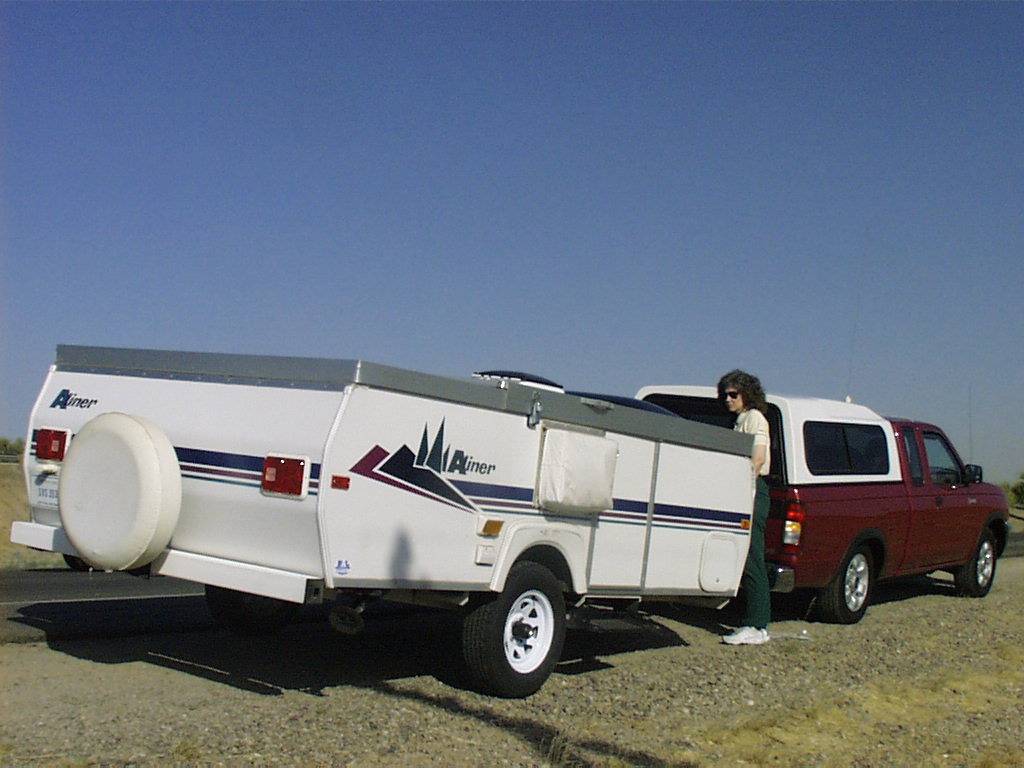
|
Grand Canyon Star Party 2005 – Travel Log, 7-12 June 2005 Michael & Mary Turner |
|
Day 1 – Tuesday, 7 June 2005 – Cold and Windy!
Following our normal schedule, we departed Tucson around 0830 hours on Tuesday, June 7, on our 5th sojourn to the Grand Canyon Star Party. We have found that spending the full 8 days of the star party at the canyon is not for us. We go up after the first weekend and spend the last 5 of the 8 days observing and doing other “touristy” things. The Weather Bug has shown strong winds and cool temperatures since last Wednesday, 1 June 2005. So, we are expecting some strong winds as we approach Flagstaff and head up into the canyon. |
| We are pulling an Aliner Expedition “pop-up” style camping trailer that was rented from Outdoor Recreation at Davis-Monthan Air Force Base. The trailer has a tare weight of 950 pounds and a maximum gross vehicle weight of 1950 pounds. I estimate that it weighs somewhere around 1500 pounds with the clothes, 3 drawer food cabinet, hiking and camping supplies, microwave oven, 12vdc refrigerator, etc. that we packed. The 1998 Nissan Frontier truck is stuffed with astronomy equipment: a Televue NP101 in its hard shell case, AP 400 mount in its Pelikan case, AP portable pier for the refractor, an Meade LX200GPS-10 in its JMI travel case with the Meade standard field tripod, a Doskocil eyepiece case, document/miscellaneous case, Coronado 60mm SolarMax Ha filter and case, Orion 90mm Mak spotting scope with SLIK tripod and white light solar filter, SBIG ST2000XM CCD camera in its Pelikan case. Also included are the “tackle box” parts and accessory box, document bag, Duralast 105Ah marine style battery in its travel case, aluminum astro-table, and the IBM ThinkPad laptop computer. At the last minute, we swapped out the 30 pack of 24 ounce water bottles for 4 24 ounce six packs of Diet Pepsi. We figured that we can get water anywhere at the Canyon, but the 24 ounce Diet Pepsi bottles would be hard to come by. This proved to be correct. The Market Plaza had 20 and 36 ounce bottles at a very elevated price. The standard star party cooler rides with us in the cab of the truck and is filled with frozen water bottles, Pepsi, and 3 pork sirloin roasts that Mary had smoked up in her Kamado. |
|
|
|
The trip to the Canyon was uneventful. We stopped for fuel just north of Phoenix and again in Butler, 5 miles east of Flagstaff on I-40. The climb up Black Canyon went well this year. We were not slowed by trucks or other campers. The slowest speed was 35 mph in 3rd gear. But, as expected, I dropped the transmission into 2nd gear on the pull up the south side of Camp Verde and dropped to 25 mph at one point. The strong winds that were expected did not materialize until we arrived in Tusyan, just south of the park entrance. And, boy, were they strong. The park information radio said the winds were 15-20 mph with gusts up to 35 mph. We checked in at the Trailer Village office and proceeded to space L-83. Setup of the trailer took approximately 20 minutes including hooking up the electricity and the clean and dirty water lines. We sorted through the astronomy equipment in the truck and prepared for our first night of observing. |
| We arrived at the west side of the Yavapai Observation Station parking lot around 1630 hours. To our delight, the parking plan that Ranger Brian had created and used for the past 2 years was in effect this year. Our new ranger, Russell, was learning the ropes about the Grand Canyon Star Party and parking madness. In year’s past, we just showed up in the parking lot and waited for a vacant space. We would then setup our telescopes. The smaller scopes went to the rear of the vehicles and the larger scopes went into a vacant space next to the owner’s vehicle. This situation caused severe problems with the shuttle buses and other vehicle traffic. Starting in 2003, ranger Brian created a scheme whereby the western-most parking spaces were blocked off, creating a “telescope lane” where the scopes and accessories were setup. The parking spaces just to the east were blocked off for the astronomers’ vehicles. This scheme allowed plenty of space to set up our equipment, plus created a visible lane for the buses and other vehicle traffic to use when navigating through the parking lot. Not all of the canyon visitors were happy about the astronomer’s taking up so many parking spaces at one of the canyon’s best sunset observing locations. During the last 2 years, only 2 known instances of visitor disagreement with the scheme have occurred, or at least been reported to a ranger. |
|
|
|
We setup the Meade LX200GPS. I tried to use the
anti-vibration pads, but the wind was blowing so badly that the pads
actually contributed to instability of the scope. They went back in the
tackle box to be used another night. Around 1900 hours I was able to
locate Jupiter, with the aid of the new Bushnell 12x50 roof prism
binoculars. Mary suggested that I try to do an automatic alignment on
the LX200GPS. To my disbelief, I found the two alignment stars that
Autostar II suggested.
The twilight talk started right on-time at 2000 hours, just after a 1944 hours sunset. Dean Ketelsen does a wonderful job of arm twisting to convince a few astronomers to do a 45 minute presentation while it gets darker. I think that all 35 or so telescopes were pointed at Jupiter until 2030 hours. The wind was really blowing and the temperature was already down to around 45 degrees F. |
|
I decided to tour the constellation Ophiuchus and its grand globular clusters: M107, M12, M10, M62, M19, M9 and M14. This observing strategy was prompted by the articles in the July 2005 issue of Sky and Telescope magazine concerning Ophiuchus and Scorpius. My first target was M10. This globular was very bright and very nicely resolved at 125x using the Nagler 20 mm Type 2 eyepiece, even in the twilight. I then moved on to M12, the virtual twin of M10. I wanted to see for myself that the two clusters were almost twins. They are! You could almost pass off a photograph of one as the other, so I guess you can believe some things mentioned in S&T J.
I next moved to M4 in Scorpius at the request of a visitor. Unfortunately, M4 was just rising and grazed the tops of the trees. The visitor wanted to see a very nice bright globular cluster, so I moved the scope to M13 in Hercules. The view was amazing as expected, except that the wind kept moving the scope due to high viewing angle of Hercules. The visitor was nonetheless impressed and requested a second look at M4 later in the night, which she received. I then slewed to M14, M107, M9, M19, M62 and, just for good measure, NGC6356. I really like looking at and talking about globular clusters. The non-astronomical visitors are taken aback when you explain the high density of stars in the cores. When the woman came back for her second look at M4, I used the euphemism of “diamonds on black velvet” to describe the cluster. She readily agreed. I would have liked to taken a few images of the clusters later after the visitors departed, but the wind and the cold got the better of me, and the images would have looked like star trails on an etch-a-sketch! We shut down and packed up at 2200 hours. |
| Day 2 – Wednesday, 8 June 2005 – Hello Mr. Sol! And Mrs. Wind, Please Go Away! |
| We began the day at 0900 hours by setting up the TVNP101 where the Blue Village Bus stops to transfer passengers to the Red West Rim Bus. Mary setup the 90mm Mak with the Thousand Oaks white light filter and entertained the first of approximately 400 visitors while I setup the AP portable pier, AP400 mount, the refractor and the Coronado Solarmax 60 Hydrogen Alpha filter. The “traffic ranger” last year had requested that we not setup right in front of the Hermit Road sign. So, this year we setup between the Hermit Road sign and the 3-way street sign (gotta keep the rangers happy!). This area kept us in the middle of the pedestrian flow, yet did not cause a congestion problem. And, the visitors could see the big Hermit Road sign. |
|
|
We had earlier checked the sun using the white light filter and the “naked eye” test to see if there were any sunspots visible. There were! Mary identified 2 very large sunspot groups with the 90 mm Mak. As I brought the NP101 on line, we were treated to several very nice prominences. I tend to start the viewing session with the Televue 19mm Panoptic eyepiece to provide a wide angle view of the sun. Today, I soon added our latest acquisition from Starizona (not counting the neat new hats from Dean!), a Televue 2.5x PowerMate. Using the Panoptic/Powemate combination, some contrast was lost at the edges of the field of view. But the “middle 2/3” was sharp as a tack. The additional magnification to 67.5x proved to be very rewarding with the Panoptic. The area around the larger of the 2 sunspots showed a very distinct filament. We were able to watch this filament and the sunspots evolve during our 3-hour viewing session. It is truly amazing to watch visitors as they take their first look at our sun through a telescope. In conjunction with a few selected solar books, having two different filters provides a nice introduction to the features of the sun.
|
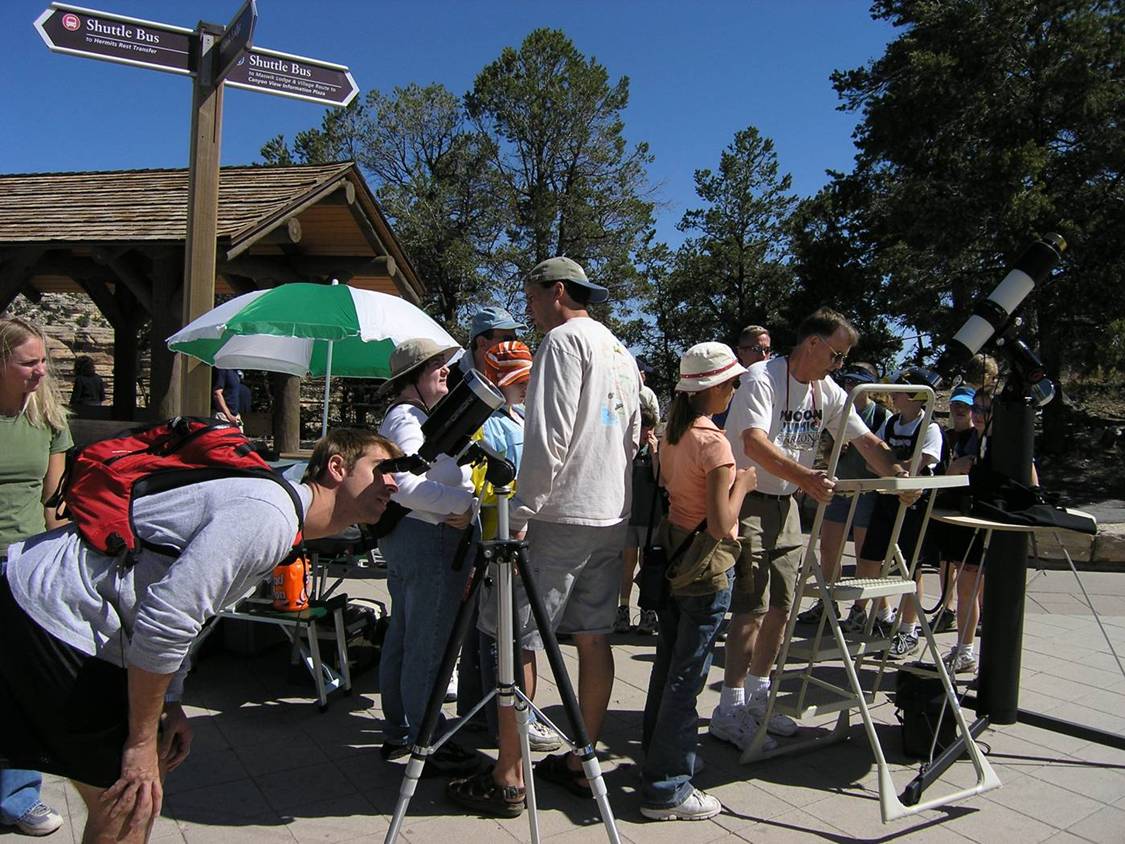 |
| After taking a break from the sun, we setup the LX200GPS in the Yavapai parking lot around 1700 hours. The wind was still howling and cold. I continued the globular cluster sojourn with M4, M80 and NGC 6144 in Scorpius. Again, this strategy was prompted by the July issue of Sky and Telescope. M4 was still a dazzling handful of diamonds on a piece of black velvet. Since the wind was not quite as bad tonight, the star “entrails” of M4 were very visible and beautiful. M80 was a nice change from the globular’s of Ophiuchus and Scorpius as noted by its small but very bright and compressed core. I was able to show M22 in Sagittarius as a comparison to the less bright globular’s in this region. I was about to check out some of the wonders of Sagittarius and the Milky Way when the wind suddenly became very cold and biting. We closed up shop around 2230 hours. |
| Day 3 – Thursday, 9 June 2005 – Rain, rain Go Away… |
| Thursday is normally our first hiking day of the week. Last year we descended down to Cedar Ridge and back. OK, for you experienced hikers, this is just a short morning walk… But, for us last year at 30 pounds heavier, it was a good trek. This year, Thursday dawned with the threat of rain. Not too much wind, but I did not want to get caught somewhere between the Bright Angel 3 Mile Rest House and the rim in a rain storm. Our alternate target for today was the Kaibab Trail hike down to the Top of Redwall Descent was also out of the question. So, we opted to ride the bus out to Hermit’s Rest and walk back. This is a nice safe trail, if a bit unmaintained between Hermit’s Rest and Maricopa Point. Did I say unmaintained? How about unmarked as well! Somewhere between Hermit’s Rest and The Abyss, we were wondering if we were still on the right path. As it turned out, we had taken the “hiking path” as opposed to the “scenic route path”. |
|
The 9.7 mile hike should have been a very nice respite from the wind and rain. Somewhere around Maricopa Point, the rain began. The last 1.4 miles seemed like an eternity. Then, we had to walk from the Red Bus Transfer Point to the Backcountry Offices as the Village bus could not get to the transfer point because an asphalt truck had toppled off the road by the El Tovar Hotel. So, no bus and plenty of rain made for a nasty little ¾ mile walk to the Backcountry Offices (whine, whine, whine…).
The wind and rain continued during the day and into the evening, so we stayed bundled up in our trailer at the Trailer Village. We were treated to an interesting formation of mammatus clouds around 1730. |
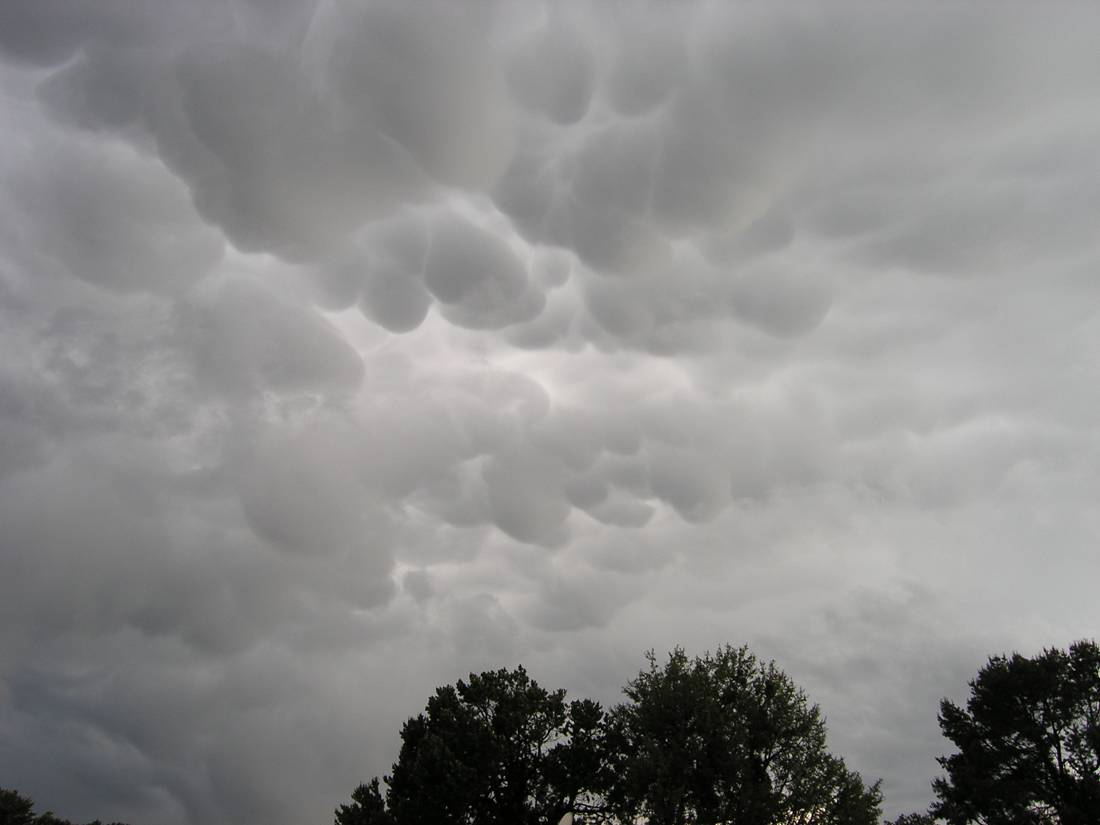 |
| The weather cleared around 2200 hours and several folks set up their scopes at Yavapai Point for the late evening. The reports that we received said that about 25 visitors showed up. So, not a total loss of the night! |
| Day 4 – Friday, 10 June 2005 – Hello Again Mr. Sol and Will The Rain Stay Away? |
|
The morning dawned with nary a cloud in the sky. What a wonderful change from the previous 3 days. We finally realized that the morning dew and cool temperatures melt into the warmth of the day around 0830 hours. So, the 2 ½ hours from rising at 0600 hours and 0830 hours were dedicated to resorting the equipment in the truck,
We drove out to the Red West Rim Bus Transfer Point at 0900 hours and setup both telescopes again. The 2 large sunspots were back as were 12 significant prominences. Mary counted at least 7 major prominences. We, and our visitors, were treated to quite a show from our Sun during our 4 hours of viewing. |
| I noticed a large prominence at a position of about 4 o’clock that was hanging on by a mere thread. A large prominence at 7 o’clock was already beginning to pancake. Another large prominence was visible at 6 o’clock. No large filaments were visible on the sunspots. Around 1015 hours, the large prominence at 4 o’clock became a solar flare. I convinced myself that I could actually see the breakaway of the prominence from the Sun. The flare was visible for about 20 minutes and provided quite a show for our visitors. The prominence at 7 o’clock became a loop as it began its fall back to the surface of the Sun. This was a great opportunity to share some pictures from the books with the visitors. The books do a much better job of explaining a “loop” than I do. The large prominence at 6 o’clock became larger and more tree-like as the morning progressed. As I was intensely watching the goings on of the other prominences, a visitor mentioned a very large tree like object at 3 o’clock. Sure enough, another large prominence had appeared, along with one at 12 o’clock. The solar viewing was great today, but we needed to head back to the trailer and rest up for the evening’s show; which, according to the weather forecast and the current conditions, promised to be what the entire week could have been…Wonderful star gazing weather. In talking to the traffic ranger we discovered that Friday is “transition day” at the canyon. The previous weeks visitors depart and new visitors arrive for the weekend. So, the visitor population was not as large as on Wednesday. | 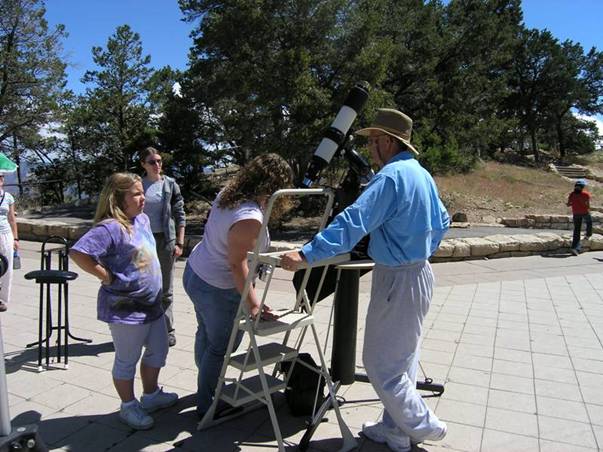 |
|
The equipment in the truck was rearranged from the morning’s solar viewing, and we headed over to Yavapai Point Observation Station around 1600 hours. Friday is our traditional “have a good meal day”, and this year was no exception. We caught the bus out to the Arizona Room, located by the Bright Angel Lodge. The dinner was great as usual. We also did some cursory window shopping in preparation for our normal Saturday shopping day. After the meal, we caught the bus back to Yavapai Point Observation Station and setup the telescope around 1800 hours. This night had all of the makings of a great observing session – no wind, not too cold, and a not overly bright moon.
|
| As twilight approached, I slipped the Nagler 3-6mm zoom eyepiece into the LX200GPS to do some “crater in a crater in a crater” wondering around the terminator. The sky was steady enough to allow the zoom to be set to 4 mm (625x) and still maintain a nice sharp object. We were able to due justice to the shores of Mare Crisium with its three large internal craters. Macrobius, with its companion crater was extremely sharp. Mary pointed out some of the “sandbar” features of Cleomedes. But, it was Posidonius that stole the show. The “mountain in a crater in a crater” showed very good elevation and definition as it was directly on the terminator. Several visitors were simply amazed that there was so much detail to be seen on our moon. | 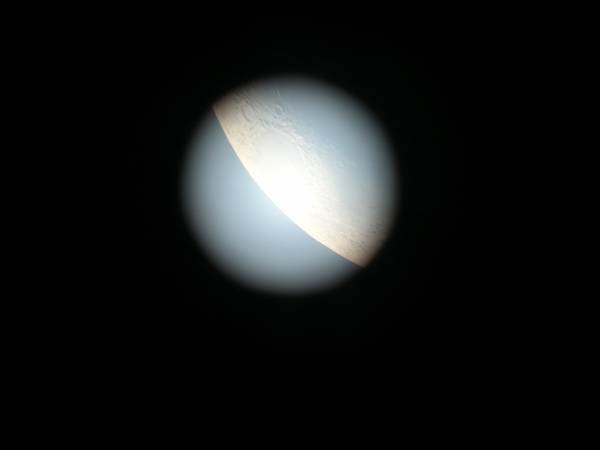 |
| The next target of opportunity was Jupiter. I really did want to show Saturn, but the trees behind us did not agree. I started out with the Televue 35mm Panoptic eyepiece (71x) to show a nice wide view of the planet and its moons. As darkness descended, I switched to the Nagler 20mm Type 2 (125x). The seeing was good enough to see quite a bit of detail on the “surface”. I counted 9 cloud bands with good detail. I figured I’d be brave and inserted the Televue 14mm Radian (179x), and the eddy’s were clearly visible. My observing neighbor from Atlanta had used his Meade LX200-10 Classic to observe the Great Red Spot Wednesday evening. As the first wave of visitors disappeared, I heard a shout of “Saturn, get your Saturn here!” The voice could only be coming from one person, our host Dean Ketelsen. He had setup his C14in the custodian parking spot which had a beautiful view through the trees to Saturn. |
| I started the evening tour with M13. The cluster
showed well in the late twilight and provided an interesting object
while the full darkness settled in. Note: The Grand Canyon Star Party
always has new visitors each night. We recognized quite a few folks who
had observed the Sun earlier in the day. Looking at the same object that
has been viewed earlier in the week may be a repeat for us, but it is a
new beginning for the visitors. Mary took over operation of the scope
and wanted to visit some faint fuzzies. She slewed to M57 and cranked
up the magnification to 208x using the Nagler 12mm Type 2 in 2 inch
mode. This is the same eyepiece that I successfully spotted one of the
central stars of the Ring Nebula in the 8 inch LX200 from the backyard
of our previous home in Tucson. The seeing would not allow any more
magnification. About 30 visitors had a long look at the Ring and were
quite impressed. Mary’s next target was the M81/M82 pair of galaxies
using the Televue 35mm Panoptic eyepiece (71x). Both galaxies just fit
into the field of view. The hard part of about showing galaxies is that
some visitors have problems “seeing” the faint fuzzies. They have been
looking at the Moon and Jupiter or other bright objects, so it takes
awhile for them to feel comfortable with the galaxies. Once adapted,
they were thrilled at seeing the objects. Mary inserted the 12mm Type 2
again and zeroed in on each galaxy, to the delight of the visitors. We spent the remainder of the evening taking in all of the faint fuzzies that would present a decent view for the visitors. We closed up shop at 0030 hours and headed back to the Trailer Village to await whatever weather Mother Nature would provide for Saturday. We did not have to wait long… |
|
Day 5 – Saturday, June 11, 2005 – Where did all of this Rain Come From? |
|
We awoke around 0330 hours to the sounds of rain pelting the trailer. This was no passing shower. This storm lasted until around 0430, when I was able to again fall asleep during the lull in the rain. We awoke about 0630, again to the sounds of heavy rain. To make this story short, it rained all day.
Saturday is our traditional 2nd hiking day of the week. We were going to walk down to the 1.5 mile rest stop on the Bright Angel Trail, but thought better of the idea after listening to the Canyon weather radio and hearing of several trail closures due to lightning. So, we drove out to the East Rim, stopping at all of the overlooks enroute. |
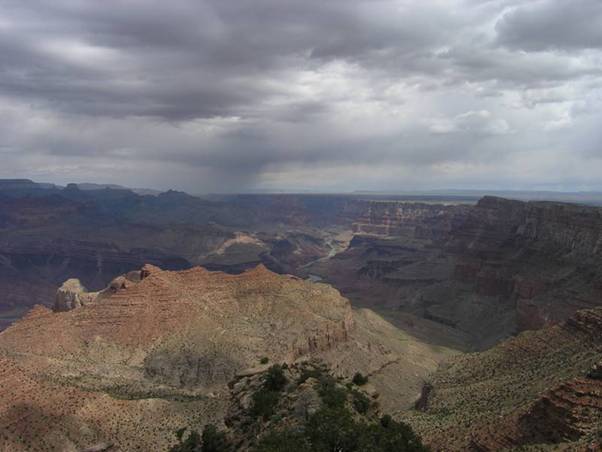 |
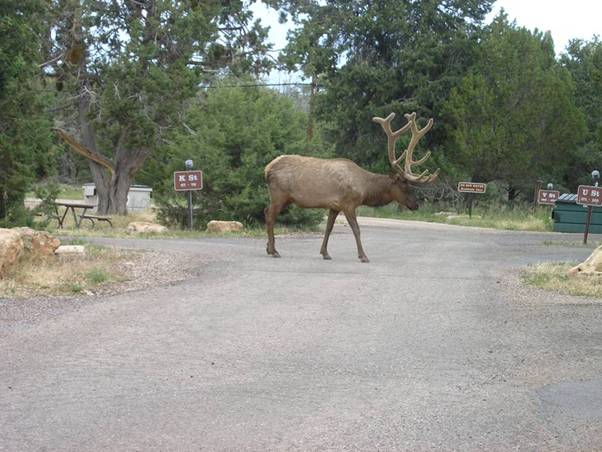 |
We returned to the Trailer Village to
start the trip over to the Wahler’s for the traditional 2nd
Saturday picnic. Upon our arrival at the trailer, we were treated to a
small herd of Elk that decided to take advantage of the new grass shoots
that were emerging in the Trailer Village.
The rain was so bad that we decided to skip the picnic. As it turned out, the picnic went on as planned, but with only a handful of attendees. Dean officially called off the night’s observing around 1400 as the weather forecast called for the same all day and into the night. So, due to the heavy rains and cool temperatures, we spent a relaxing evening in the trailer reading. |
| Day 6 – Sunday, June 12, 2005 – Time to go home… |
| We awoke around 0600 to a sparkling blue sky and virtually no wind. This weather did not last long. By the time we had the truck packed and the trailer stowed, the sky had clouded up and the winds had started. We departed the park at 0830. The trip to Tucson was, fortunately, very uneventful. We did manage make it to the I-17/Loop 101 junction before turning on the air conditioner. |
|
Recap. Even with the less than desirable weather, rain and wind, we are planning to attend the 16th Grand Canyon Star Party tentatively scheduled for 17-24 June 2006. This star party is really about giving the public a chance to observe our magnificent Arizona skies under almost perfect conditions. We find that we only have about 4 waking hours a day to ourselves, but that is ok. We really enjoy talking to the park visitors from around the world and showing them a little piece of serenity.
Thank you Dean…
|
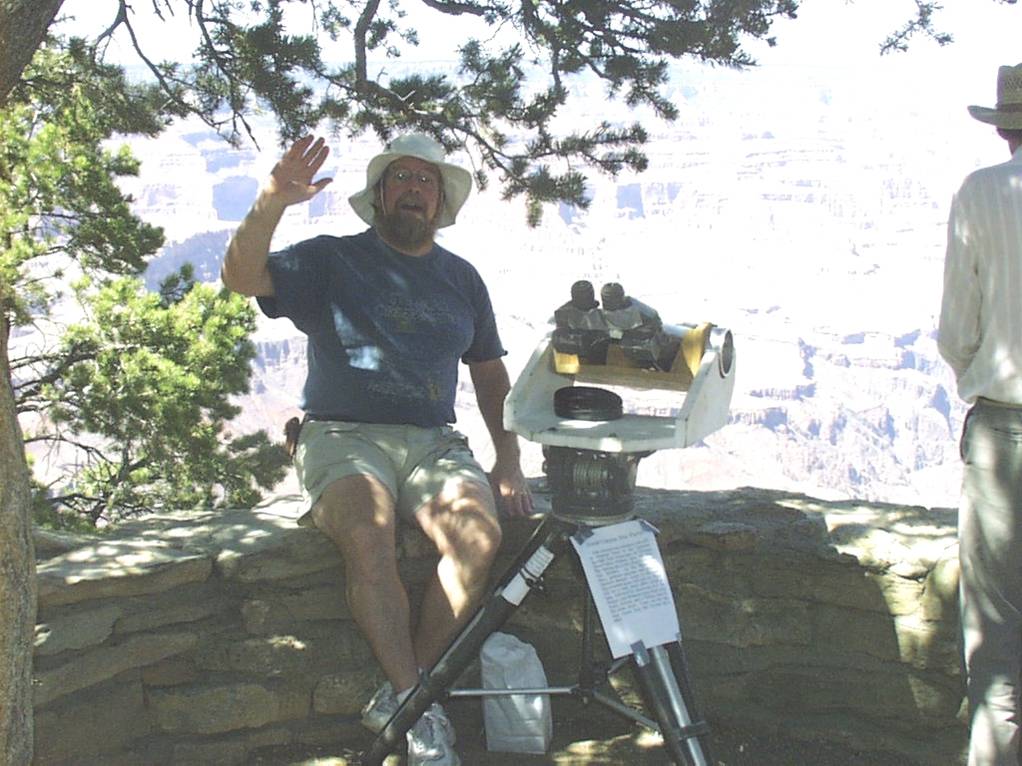 |